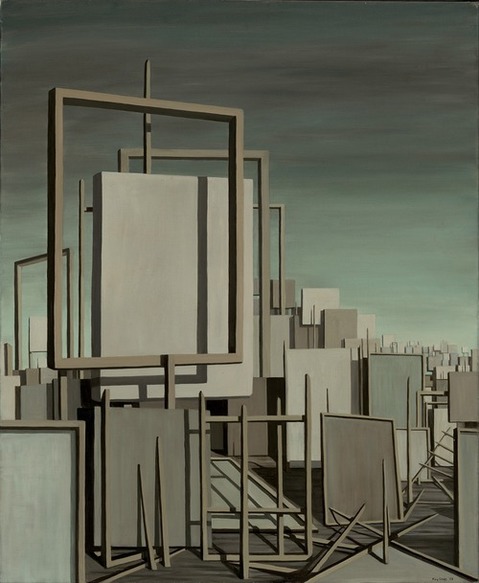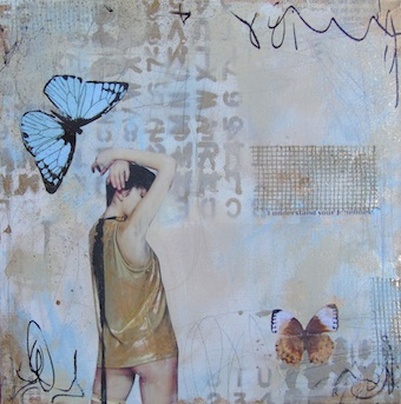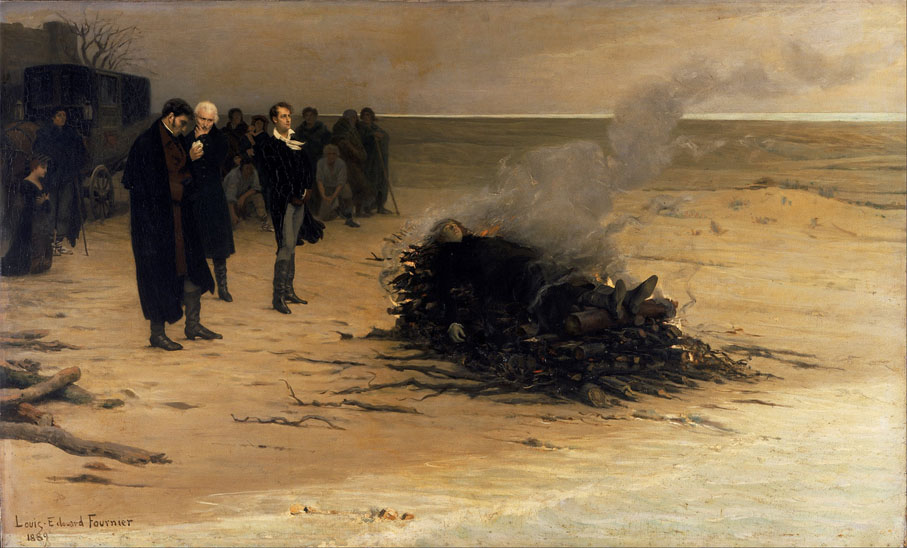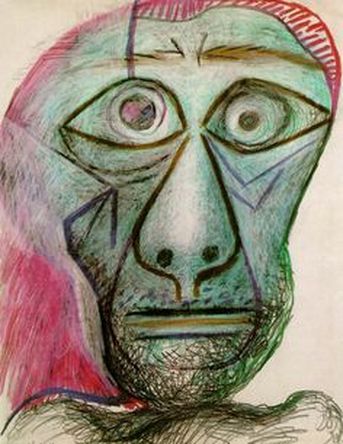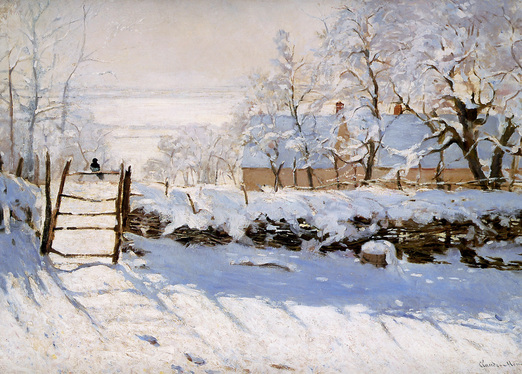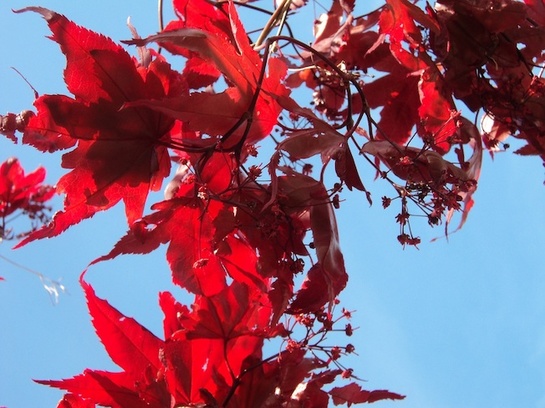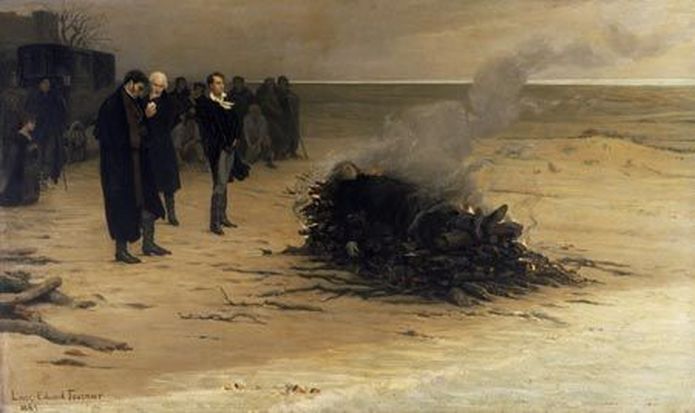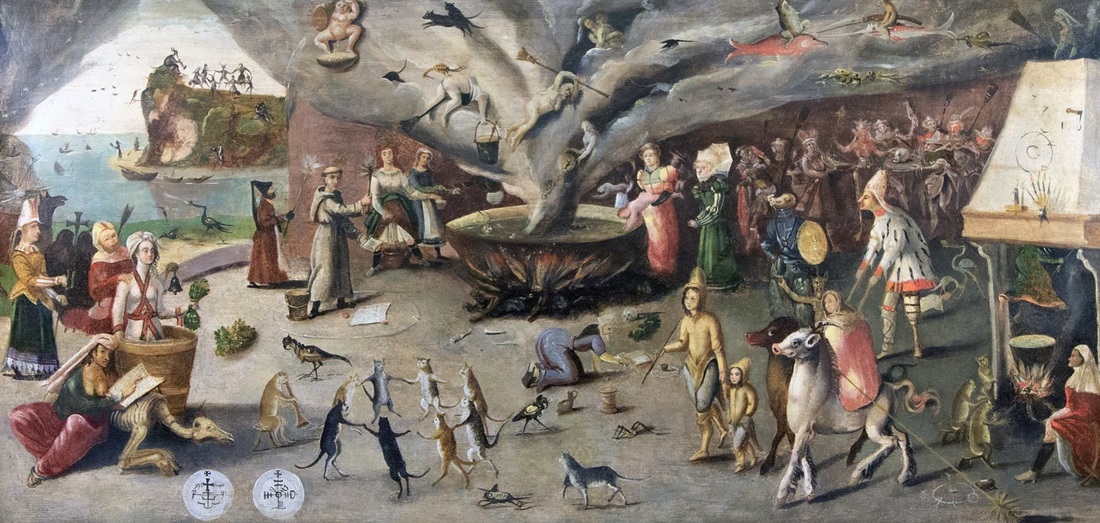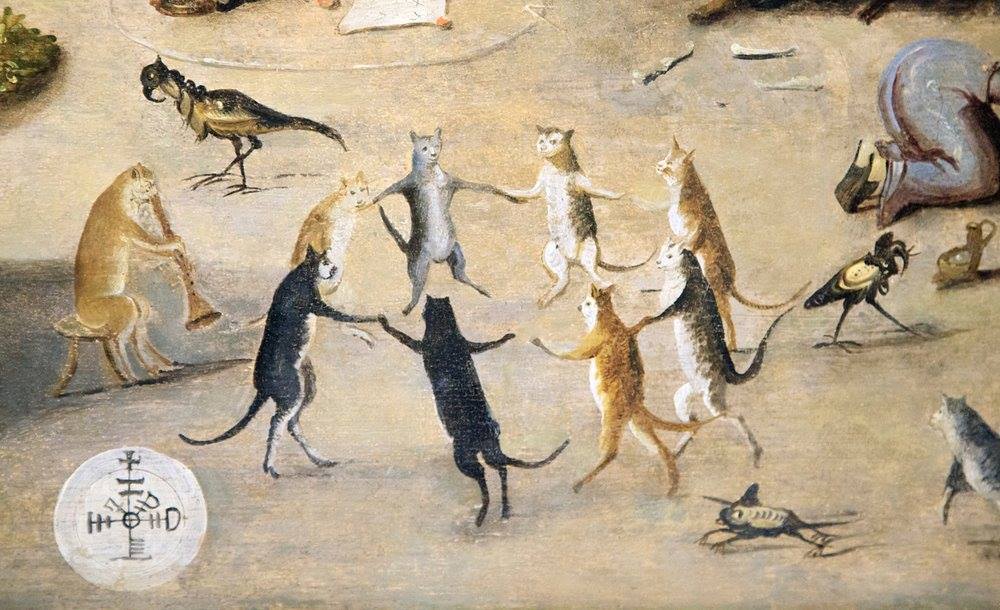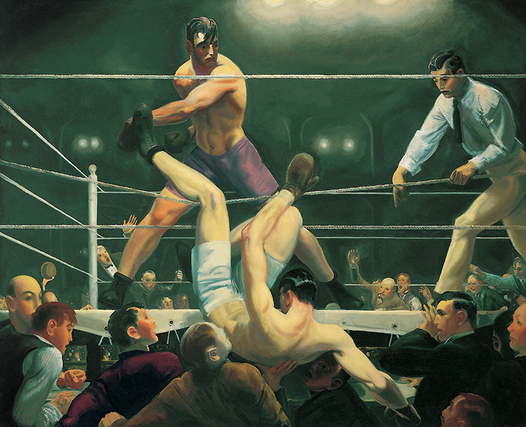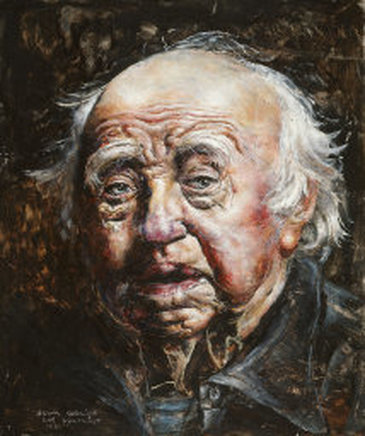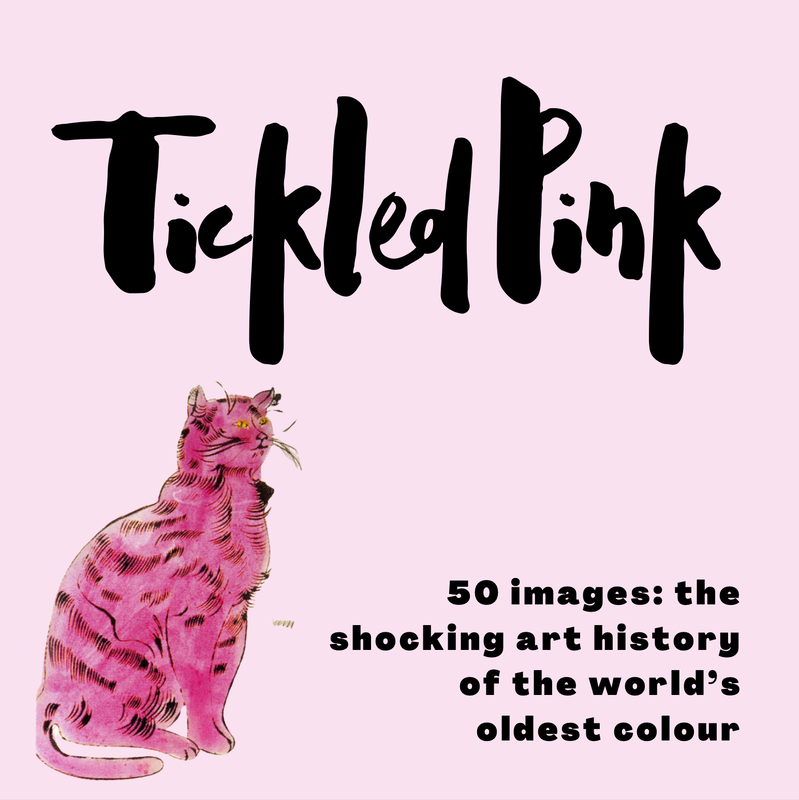|
At the Rally Glut of rectangles. A few squares. Angled shoulders dig hard into reporters locked inside a square box where cubed fingers tap on rows of quadrilateral devices. Way in the back by a perfect right angle, an oval shouts something cursive, is escorted outside by hard-edged isosceles trapezoids who march up linear aisles perpendicular to the plane of the wall. Suddenly a squeal from a place near intersecting diagonals--a circle is hiding! Bare knuckles swing for the radius. The circle calls out theorems and proofs. The crowd goes crazy. Squares form a Rubik’s cube in the chaos. A rhombus stands up, reminds that proofs are artifacts of political correctness. The circle rolls down the aisle, slips away. A golden trapezium stands at the podium. Kathleen Stancik This was written for the 20 Poem Challenge. Kathleen Stancik recently discovered ekphrastic poetry and finds it an exciting way to stimulate creativity. Her poems have been published in Manastash and Poet's Unite! The LiTFUSE @10 Anthology.
1 Comment
Lepidoptera: after Lorette
of course, each life matters the embryonic and the homeless those lost to themselves in muttering frenzies of precipitous days the rubble-shrouded children of Aleppo crucified saints of Sudan coke-heads of Manila, and also, the trans-gendered below Kingston’s ghettos -- but these gone lives I particularly know: young Trayvon, breath-stopped Eric, distraught Sandra Bland, many who should be living now -- and somewhere, in a civilized, suburban basement, this child also, among the lepidopterist’s cases collecting nightmares in the formaldehyde of an old man’s lusts -- pinned to this daguerreotype of a sketch, she matters, she matters John Robert Lee JOHN ROBERT LEE (b. St. Lucia 1948) has published several collections of poetry. His short stories and poems have been widely anthologised. His reviews and columns have appeared with regularity in newspapers, local and regional. He has also produced and presented radio and television programmes in St. Lucia for many years. His books include Saint Lucian (1988), Artefacts (2000),Canticles (2007), Elemental (2008), Sighting (2013), City Remembrances (2016). He compiled and edited Roseau Valley and other poems for Brother George Odlum (2003), Bibliography of Saint Lucian Creative Writing 1948-2013 (2013); he co-edited Saint Lucian Literature and Theatre: an anthology of reviews (2006) with fellow St. Lucian poet Kendel Hippolyte and co-edited Sent Lisi: poems and art of Saint Lucia (2014) with Kendel Hippolyte, Jane King and Vladimir Lucien. West Wind
“Lift me as a wave, a leaf, a cloud...” (Percy Bysshe Shelley, "Ode to the West Wind") We let the west wind take his remains. Gentle, she bore each flaming ash skyward to burn with momentary brilliance then vanish like an unremembered word. And in the end, there was little left-- an unremarkable band in black who mourned in minor voices and the west wind who did not pause to grieve. Steve Deutsch This was written as part of the 20 Poem Challenge. Steve Deutsch, a semi-retired practitioner of the fluid mechanics of mechanical hearts and heart valves, lives with his wife Karen--a visual artist, in State College, PA. Steve writes poetry, short fiction and the blog stevieslaw@wordpress.com. His most recent publications have appeared in The Ekphrastic Review, New Verse News, Silver Birch Press, Misfit Magazine and One-sentence poems. Self-Portrait Facing Death It looks like a crude thing a child might draw with its crayoned pink and simple features little more than a doodle with a face, though after peering at it for a while it begins to appear less infantile. See how the stubble on the upper lip, the hair on the jaw, the bony shoulders, give the figure an archetypal feel something totemic a tribesman would paint or is it an image more ancestral still, the low forehead, ape-like skull and brow evoking mankind in primordial times and this rough-hewn visage our prototype? But study the face’s geometry, for are the mouth and lips parallel lines, those eye sockets distorted rectangles, the nose and the creased skin beneath forming semi-circles and triangles, and do not these symbols of abstraction suggest an intellectuality and the evolution of modern man? It seems all of these, yet it is the eyes that mesmerize, wide open and exposed those portals to the aging artist’s soul, bewildered, vulnerable, yet resolute, displaying fear and courage facing death, their gaze both a window and a mirror. Then I realize that this masterpiece contains us all and is everything we are and everything we have been. Ian Fletcher Born and raised in Cardiff, Wales, Ian has an MA in English from Oxford University. He lives in Taiwan with his wife, two daughters and cat. He teaches English in a high school. He has had poems and short stories published in 1947 A Literary Journal, Dead Snakes, Schlock! Webzine, Short-story.me, Anotherealm, Under the Bed, A Story In 100 Words, Poems and Poetry, Friday Flash Fiction, and in various anthologies. Monet's The Magpie, 1872
A house behind trees, steep-pitched roof, red chimneys, fence and gate horizontal at the scene's centre— caesura from white, silver, gold snow which cushions, catches in crooks. Swirled strokes convey layers, echo arched tree limbs. On the top rung of a warped gate a magpie basks, beak cocked in silhouette, tail feathers angled right, same as shadows that point to the canvas bottom corner where Monet's signature slants. Past the magpie's umbra, dark tracks (boot or hoof) walk off the painting, invite you to enter, feet tingling. Distant fields stretch, fuse with sky, late day sun unseen reflects from every surface onto your face imprinting. Karen George Karen George is author of the poetry collection Swim Your Way Back (Dos Madres Press, 2014), and four chapbooks, most recently The Fire Circle (Blue Lyra Press, 2016). Her work has appeared in America, Adirondack Review, Naugatuck River Review, Louisville Review, and Still. She reviews poetry and interviews poets at Poetry Matters: http://readwritepoetry.blogspot.com/, and is co-founder and fiction editor of the journal, Waypoints: http://www.waypointsmag.com/. Her website is: http://karenlgeorge.snack.ws/. Three D Art
Trees that blaze bright red are not danger signs warning of perils, but colourful explosions of vain Mother Nature showing her creatures she is the master artist. Gary Beck Gary Beck has spent most of his adult life as a theater director, and as an art dealer when he couldn’t make a living in theater. He has 11 published chapbooks and 3 more accepted for publication. His poetry collections include: Days of Destruction (Skive Press), Expectations (Rogue Scholars Press). Dawn in Cities, Assault on Nature, Songs of a Clerk, Civilized Ways, Displays, Perceptions (Winter Goose Publishing). Fault Lines, Tremors, Perturbations, Rude Awakenings and The Remission of Order will be published by Winter Goose Publishing. Conditioned Response (Nazar Look). Resonance (Dreaming Big Publications). His novels include: Extreme Change (Cogwheel Press), Flawed Connections (Black Rose Writing) and Call to Valor (Gnome on Pigs Productions). Acts of Defiance will be published by Dreaming Big Publications, Sudden Conflicts by Lillicat Publishers and State of Rage by Rainy Day Reads Publishing. His short story collection, A Glimpse of Youth (Sweatshoppe Publications). Now I Accuse and other stories will be published by Winter Goose Publishing. His original plays and translations of Moliere, Aristophanes and Sophocles have been produced Off Broadway. His poetry, fiction and essays have appeared in hundreds of literary magazines. He currently lives in New York City. Shelley's Farewell Now at last I lay at rest upon this prickly pyre, cradled in this smoking nest enveloped by the fire. To leave behind what I detest remains my one desire, to turn my back on life's cruel jest escape the loveless mire. Let mourners wail in tones distressed, perhaps they are not liars. But I alone am truly blessed as twilight lifts me higher. Kati Nagy This was written as part of the 20 Poem Challenge. Kati Nagy is a semi-retired, globe-trotting ESL teacher who now resides in San Francisco with a view of the sparkling Bay Bridge. She weaves her stories in poems, collages, memoir, and solo performances. Surprise Hook “Good morning, ladies and gentlemen,” he began each trig class. Unflappable. Mr. Thurston, with his silver hair and military bearing – always in coat and tie, could have stepped out of a 1930s movie. The butler. There I sat – the lone girl surrounded by teenage testosterone. He often told us, “When you become an engineer…,” as I glazed over. So I’m glad I was paying attention the day he asked, “Does anyone know who Firpo was?” Firpo was before our parents’ time. A long pause. “No one?” “He was a boxer,” I answered. I cared nothing for sports, but I did know a thing or two about art. Alarie Tennille This poem was written as part of the 20 Poem Challenge. Alarie Tennille was born and raised in Portsmouth, Virginia, and graduated from the University of Virginia in the first class admitting women. She became fascinated by fine art at an early age, even though she had to go to the World Book Encyclopedia to find it. Today she visits museums everywhere she travels and spends time at the Nelson-Atkins Museum of Art in Kansas City, Missouri, where her husband is a volunteer guide. Alarie’s poetry book, Running Counterclockwise, contains many ekphrastic poems. Please visit her at alariepoet.com. Self-Portraits
Twenty times the artist revisited the wreckage of his face the way I do certain photographs—the dead stacked like cordwood at Buchenwald, the naked girl running from napalm at Trang Bang, the suited man plummeting on 9/11. These people knew death first hand, were its messengers. Like Terence, Albright claims through his blasted faces: Homo sum, humani nihil a me alienum puto. “Nothing human is alien to me—even if I have become an alien to myself.” I bow to Albright’s bravery. I still stagger when I face my corruption in the mirror—my waist given out like rotten elastic, my skin creped, my once thick hair stubble on a razed field. Each of his portraits catalogues the horror anew—age spots, puffiness, wrinkles, balding, fear, rheumy eyes. Each one bellows: I am staring down the worst of it and still, Homo Faber, I create. In a world that worships youth, what is more gruesome than an old woman—unsexed, blown? Yet, like Albright, I would revisit my demise in endless variations, even as he did, until his final days, reduced and reduced until all that remained were his fierce eyes. Perhaps my poems will distill me, godlike, to a single word, my own yod-hey-vav-hey. Devon Balwit Devon Balwit is a poet and educator from Portland, Oregon, who learned to love art from her artist parents. Her poetry has appeared in numerous journals, among them: 3 elements, 13 Myna Birds, Anti-Heroin Chic, Dream Fever Magazine, Dying Dahlia Review, Emerge Literary Journal, Free State Review, MAW, Rat's Ass Review, Rattle, Red Paint Hill Publishing, Referential, Serving House Journal, The Cape Rock, The Literary Nest, The Yellow Chair, Timberline Review, vox poetica, and Vanilla Sex Magazine. She welcomes contact from her readers. |
The Ekphrastic Review
COOKIES/PRIVACY
This site uses cookies to deliver your best navigation experience this time and next. Continuing here means you consent to cookies. Thank you. Join us on Facebook:
Tickled Pink Contest
April 2024
|
